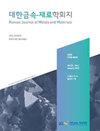镀镍层间层对镀银铜片抗氧化性能的影响
IF 1.1
4区 材料科学
Q4 MATERIALS SCIENCE, MULTIDISCIPLINARY
引用次数: 0
摘要
为了抑制银包覆Cu (Cu@Ag)片在200℃左右的脱湿,采用连续化学镀镍和银制备了银和镍包覆Cu (Cu@Ni@Ag)片。镍浴类型是导致银脱湿和铜氧化差异的重要因素。酸性镍浴含有琥珀酸作为络合剂和次亚磷酸钠作为还原剂,碱性镍浴含有柠檬酸钠作为络合剂和氢氧化钠作为pH调节剂和次亚磷酸钠。一种含柠檬酸钠、氢氧化钠和水合肼作为还原剂的肼基镍浴。酸性Ni浴提供了P含量约为10 wt%的非晶态涂层。Cu@Ni@Ag薄片在350℃下开始Ag脱湿和Cu氧化,并形成Ni3P相。同时,碱性Ni浴生成Ni-5 wt% P的非晶态Ni涂层,在350℃加热后转变为结晶相。在450℃下脱湿银壳,导致薄片氧化。最后,基于肼的Ni浴形成了不含P的结晶涂层,这导致了与核心Cu的快速混合。混合Cu-Ni合金上的Ag壳层表现出抑制的脱湿行为,因此脱湿氧化温度最高,如500℃。提高在约300℃下的高抗氧化性将使Cu@Ni@Ag薄片作为导电浆料的低成本填充材料,特别是用于长时间或高温固化。本文章由计算机程序翻译,如有差异,请以英文原文为准。
The Effect of Ni Interlayer Formation Plating Bath on the Suppression of Oxidation of Ag-Coated Cu Flakes
To suppress Ag dewetting from around 200 oC in Ag-coated Cu (Cu@Ag) flakes, Ag and Ni-coated Cu (Cu@Ni@Ag) flakes were fabricated by successive Ni and Ag electroless plating. The Ni bath type was an important consideration to induce differences in the Ag dewetting and resultant Cu oxidation. An acid Ni bath contained succinic acid as a complexing agent and sodium hypophosphite as a reductant, and an alkaline Ni bath contained sodium citrate as a complexing agent and sodium hydroxide as a pH adjuster as well as sodium hypophosphite. A hydrazine-based Ni bath contained sodium citrate, sodium hydroxide, and hydrazine hydrate as a reductant. The acid Ni bath provided amorphous coatings with a P content of approximately 10 wt%. The Cu@Ni@Ag flakes started the Ag dewetting and Cu oxidation at 350 oC, together with the formation of the Ni3P phase. Meanwhile, the alkaline Ni bath created Ni-5 wt% P amorphous Ni coatings, which transformed into a crystalline phase after heating at 350 oC. The Ag shell was dewetted at 450 oC, which caused oxidation of the flakes. Finally, the hydrazine-based Ni bath formed crystalline coatings without P, which induced rapid mixing with the core Cu. The Ag shells on the mixed Cu-Ni alloy showed repressed dewetting behavior, and thus the dewetting and oxidation temperature was the highest, such as 500 oC. Enhancing the high oxidation resistance at approximately 300 oC will enable the use of Cu@Ni@Ag flakes as a low-cost filler material in conductive pastes, especially for long-time or high-temperature curing.
求助全文
通过发布文献求助,成功后即可免费获取论文全文。
去求助
来源期刊

Korean Journal of Metals and Materials
MATERIALS SCIENCE, MULTIDISCIPLINARY-METALLURGY & METALLURGICAL ENGINEERING
CiteScore
1.80
自引率
58.30%
发文量
100
审稿时长
4-8 weeks
期刊介绍:
The Korean Journal of Metals and Materials is a representative Korean-language journal of the Korean Institute of Metals and Materials (KIM); it publishes domestic and foreign academic papers related to metals and materials, in abroad range of fields from metals and materials to nano-materials, biomaterials, functional materials, energy materials, and new materials, and its official ISO designation is Korean J. Met. Mater.
 求助内容:
求助内容: 应助结果提醒方式:
应助结果提醒方式:


